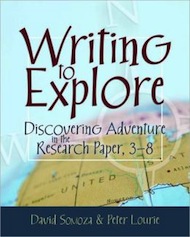Research, Adventure & CCSS
Writing to Explore: Discovering Adventure in the Research Paper
By David Somoza and Peter Lourie
(Stenhouse Publishers, 2010 – Learn more)
Like many other teachers in states that have adopted the Common Core, I’ve been re-thinking the way we can approach research projects with my sixth grade students. The new standards not only increase the expectations of research-based reading and writing across the content areas, they also expect these skills to be taught in younger grades and with increasingly more complexity as the students get older.

Writing to Explore by David Somoza and Peter Lourie seeks to turn our concept of a research paper on its head, and while the book is explicitly aimed at grades 3-8, I would suggest that the main idea here – writing an adventure essay using real research and facts – might have a place in classrooms even beyond that grade range.
In fact, even with the Common Core, there are many places where the push towards expository and informational text writing is balanced by the effective use of narrative writing. Writing to Explore and the idea of a hybrid essay may be one path forward.
Blending research facts into adventurous writing
The book was conceived when Somoza, a teacher, began corresponding with Lourie, a writer of children’s books, about ways to help Somoza’s elementary school students become more invested as writers. Over time, what the two men realized is that a fusion of adventure-style writing buffered by facts and information from research could bring out the best of both worlds: fiction and non-fiction writing.
Their main project is built along the lines of a Heroic Quest story format, but the projects are rooted in a real place with real historic significance. The research phase of the adventure essay might seem familiar. It’s the gathering of important details and facts from a variety of reputable sources. But the presentation of that knowledge is done within the framework of a fictional adventure story, with emphasis on setting (so that the research can be used most effectively).
I appreciated the honest reflections here as Somoza shares how he implemented their ideas. The book is a nice mix of the letters that Lourie and Somoza sent back and forth (sometimes while Lourie was on location, scouting out settings for his own books), handy guidelines and teaching moments, and also some exemplary student work.
The adventure essay covers a lot of ground and might just hook those students (and teachers) to whom the phrase ‘research project’ conjures up groans and moans and dismay.
Kevin Hodgson is a sixth grade teacher in Southampton, Massachusetts, and is the technology liaison with the Western Massachusetts Writing Project. Kevin blogs regularly at Kevin’s Meandering Mind and tweets more often than is healthy under his @dogtrax handle.




































1 Response
[…] Kevin Hodgson, a sixth grade teacher in Southampton, Massachusetts, has been rethinking the way he approaches research projects with his students since his state adopted the Common Core. “The new standards not only increase the expectations of research-based reading and writing across the content areas, they also expect these skills to be taught in younger grades and with increasingly more complexity as the students get older,” Kevin explains. And if the expression “research project” elicits groans from you and your students, Kevin thinks the adventure essay and the strategies in Writing to Explore might be the cure. Read the full review here. […]